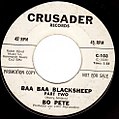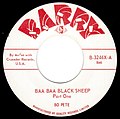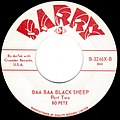Baa Baa Blacksheep (song)
| Baa Baa Blacksheep | |
|---|---|
| Harry Nilsson aka "Bo Pete" | |
| publication | 1963/1964 |
| length | 1:55 |
| Genre (s) | pop |
| Author (s) | Harry Nilsson |
| Publisher (s) | Robin Hood Music |
| Label |
Lola Records Crusader Records |
Baa Baa Blacksheep is a pop song by the young singer-songwriter Harry Nilsson . The recording was produced by John Marascalco in 1963 . It is uncertain whether the first release appeared in late 1963 on Marascalco's Lola Records or only in 1964 on Crusader Records under Nilsson's pseudonym "Bo Pete". The title and the background vocals quote the English nursery rhyme Baa, Baa, Blacksheep , which is based on the 18th century melody of the French song Ah! vous dirai-je, maman is sung. On the back of the single is an instrumental version called Baa Baa Blacksheep Part Two . Like all of Harry Nilsson's early singles, Baa Baa Blacksheep also remained un charted .
Emergence
Harry Nilsson met his colleague John Marascalco at a demo session for the songwriter Scott Turner in 1962. In the following year Nilsson and Marascalco composed a few songs together, which they wanted to record in the fall despite an ongoing contract that bound Nilsson to Mercury Records for a year . On the program was Baa Baa Blacksheep , a song that Nilsson had written alone. Nillson recalled, “I was in a little studio one day, we were hanging out there doing demos, when I heard these teenage girls sing four-part harmonies as I walked by. They called themselves The Beach Girls. They had that certain pristine and natural look and I was like, 'Oh, that's cool!' I was working on 'Baa Baa Blacksheep' and I said to the girls, 'Come on in for a minute' and I started playing the song. I said, 'Do you sing the background something like the Raylettes.' ”The“ little studio ”was the Hollywood Central Recording Studio on Cahuenga Boulevard in Hollywood, Los Angeles, and there were the Beach Girls, Nilsson, producer Marascalco and unknown people Session musicians have a studio employee named "Bo Pete", whose name was chosen as a pseudonym for the contracted Nilsson. From the master tape a test pressure on originated acetates , on the back, the enriched organ sound instrumental track of the play was. Marascalco commissioned the Californian pressing plant Monarch Records to produce the records , which pressed the first editions at the end of 1963. It was not until February 17, 1964 that Marascalco Nilssons registered the copyright for his own publishing house, Robin Hood Music.
Musical structure and content
Baa Baa Blacksheep is based on the English nursery rhyme of the same name, which can be traced back to 1731. Usually he will listen to the melody of the French nursery rhyme Ah! vous dirai-je, maman from 1761. The melody popular in Europe and America was widely used, for example through Wolfgang Amadeus Mozart's Twelve Variations of "Ah vous dirai-je, Maman" , Hoffmann von Fallersleben's morning comes Santa Claus , the alphabet song and the American children's song Twinkle, Twinkle, Little Star . The background takes on the distinctive melody in the first verse and carries it out in four voices, while the singer plays around the topic in the style of a jazz improvisation and thus also comments. In the second verse, the singer takes over the main voice, but still leaves the hook to the female voices.
Publications
Baa Baa Blacksheep was released on three different labels, all of which kept the composition with Nilsson's vocal version on the A and the instrumental version on the B side. The exact issue dates and thus the order of the two American releases on Marascalco's own label Lola and on Crusader Records are unclear: the source information “LO-102-A” or “LO-102-B” in the area of the run-out groove indicates this that the pressing was intended for Lola Records. An ID from the Monarch Records press shop on the left also means that production was dated to November / December 1963. While an exact release date of Lola 102 is not known, a release in March 1964 is given for the sublicensing of the recording to Crusader. For this purpose, the Crusader with a wider reach used exactly the same press copy as Lola, crossed out the source and the Monarch ID and added its own edition "C-103" as the source. While on Lola 102 Harry Nilsson is named as the interpreter for the first time by real name, Crusader took over the pseudonym "Bo Pete" from the test pressing. The third release took place later in 1964 on the Canadian label Barry Records under the number 3246.
Importance, Criticism, and Success
The publication on Lola 102 was hardly noticed by the literature, but could be the first record that Harry Nillson published under his own name as an interpreter. After all, Crusader 103 sold so often that Marascalco was able to use the proceeds to publish another jointly produced material: With Do You Wanna (Have Some Fun)? and Groovy Little Suzie were released in August 1964 under the pseudonym "Bo-Pete" on Try Records, two tracks that had already been recorded the week before the Baa-Baa Blacksheep session. The record failed to achieve a chart placement. Nilsson's biographer Alyn Shipton said, “It's not a particularly good record, but it gives a good idea of the vocal ingenuity that characterizes Nilsson's later work, particularly on the album Nilsson Sings Newman , on which he both soloed and soloed with his own voice also contributes the background choir. ”No cover versions of Baa Baa Blacksheep are known.
Individual evidence
- ↑ a b c d e Alyn Shipton: Nilsson. The life of a singer-songwriter . 1st edition. Oxford University Press, Oxford 2013, ISBN 978-0-19-975657-5 , Good Old Desk, pp. 32 f . (American English).
- ^ Peter Doggett: Session '62. Harry Nilsson. The Debut Sessions . Retro Records, Sheffiels 1995 (CD booklet from Retro Records retro 804).








